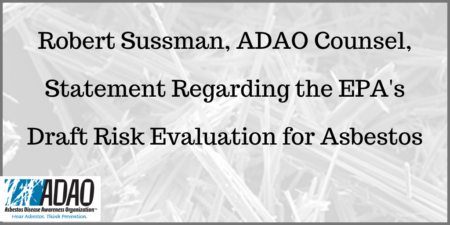Posted on June 8, 2020
STATEMENT OF BOB SUSSMAN ON EPA ASBESTOS RISK EVALUATION

My name is Bob Sussman. I’m counsel to the Asbestos Disease Awareness Organization (ADAO) and was a senior EPA official in the Clinton and Obama Administrations.
Asbestos is not any chemical but a uniquely hazardous substance that has taken the lives of over a million Americans and continues to kill nearly 40,000 people in the US each year. Asbestos use has declined but the draft evaluation indicates that the remaining active uses result in asbestos exposure by over 1.5 million workers and up to 32 million “do it yourself” consumers who replace asbestos brake pads and clutches. This is without counting the millions of Americans who are exposed to legacy asbestos but are outside the scope of the EPA evaluation.
This is the first comprehensive evaluation of asbestos in 35 years. The EPA IRIS program issued a definitive, peer-reviewed assessment in 1988 which, with some refinements, is the foundation for the EPA, OSHA and state asbestos regulations that are in place today. Unfortunately, EPA’s draft evaluation departs from this long-standing framework and calculates a considerably lower cancer risk than EPA’s 1988 IRIS assessment. Because of this lower risk, the EPA approach if finalized would require rethinking of all existing asbestos protection programs.
EPA’s approach focuses on a single fiber type (chrysotile), bases risk estimates on two studies that purportedly reflect exposure to this one fiber and uses a non-linear exponential model that is claimed to “best fit” the data in these studies.
This is very similar to an unsuccessful effort in 2008 to replace the IRIS assessment with fiber-specific potency values. There was considerable opposition at the time from asbestos experts and EPA pulled the plug after a highly critical report from the EPA Science Advisory Board (SAB). The thrust of much of the criticism was that the data did not support differential risk estimates for individual fibers and that the most defensible approach was to derive a single Inhalation Unit Risk (IUR) for all fibers based on a cross-section of the best studies.
Now, the discredited fiber-specific approach is being revived in the draft TSCA evaluation. SACC should carefully consider whether it is wise to go down this road.
The premise of the chrysotile only approach is that all active asbestos uses only involve chrysotile. But in fact talc-based industrial and consumer products contaminated with asbestos contain amphiboles as well as chrysotile. In addition, many legacy products contain multiple fiber types and, as a result, real world exposure is to different fibers in combination.
EPA has announced that it plans a further evaluation to address legacy exposure. Will this require developing IURs for other fibers? And how will these IURs relate to the chrysotile-only IUR since the additional evaluation will presumably address the total risk from current and legacy products and therefore the health impacts of several fibers combined?
Switching gears, I want to emphasize ADAO’s concern that EPA is shockingly uninformed about the specifics of asbestos use and exposure. The draft evaluation repeatedly admits EPA has virtually no information on the asbestos-containing products that we import – including the quantities, the number of end-users and the sites where asbestos exposure occurs. There’s even serious doubt whether EPA has identified all active asbestos uses – for example, asbestos cement and fabric have been consistently reported in USGS summaries of imports of asbestos-containing products but are excluded from the draft evaluation.
Based on the many information gaps in the problem formulation, we saw this situation coming and, along with several states, petitioned EPA to use its authority under TSCA to require industry to report comprehensive import, use and exposure information to inform the risk evaluation. But EPA refused and now we are seeing the consequences of this self-created information void.
SACC has previously criticized EPA for inadequate efforts to obtain information that would reduce uncertainties in its risk evaluation. Asbestos presents an extreme example of this failure and we urge SACC to highlight it in its report.
Thank you for this opportunity to share our concerns.
